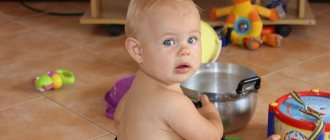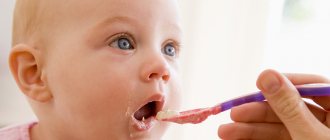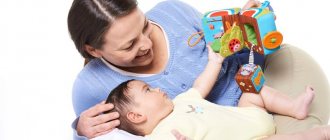Six months is an important milestone in a baby's development. During this period, a giant leap occurs in the formation of the child’s brain: tens of millions of neural connections are formed every hour.
Now the left hemisphere “communicates” with the right, which means that the baby can synchronously move his arms and legs, swing back and forth and transfer a toy from one hand to the other.
And this is a great achievement! How to develop a child at 6 months so as not to cause harm to the nervous system and help the toddler master all age-appropriate skills?
Features of the development of boys and girls at six months
At this age, most babies begin to develop teeth.
The lower central incisor goes first, and sometimes two at once. The appearance of teeth is a painful process, accompanied by itching and swelling of the gums, which greatly worries the baby. He begins to rub his face, touches his ears, and may have a fever. Unfortunately, it is impossible to speed up this process.
Gum massage, which must be done very carefully, will help ease teething and at least slightly reduce discomfort. The development of boys and girls at six months is generally similar, with the exception of height and weight. Approximate indicators are given in the table.
| Boys | Girls | |
| Height (cm) | 63,0-71,5 | 62,2-70,1 |
| Weight, kg) | 6,5-9,5 | 6,1-8,7 |
| Head circumference (cm) | 41,5-45,6 | 40,0-44,5 |
| Chest circumference (cm) | 41,3-47,7 | 41,5- 45,9 |
This month the baby gains 600-650 g of weight and grows by 2 cm.
What can a 6 month old baby do?
The baby is growing up rapidly. Parents notice their baby doing something new every day.
Physical development:
- rolls from back to stomach in both directions. Lying on his stomach, he can raise his head and chest, leaning on his outstretched arms, and when lying on his back, he can raise his head and catch his outstretched legs with his hands;
- swings back and forth on his knees and tries to move forward in this way;
- sits with support;
- grabs a toy from any position and transfers it from one hand to another;
- stands up with the help of adults and jumps when supported;
- takes an object from the palm;
- drinks from a sippy cup and eats from a spoon;
- tries to sit;
- vision improves. Now the baby sees the object not only close, but also from afar, from a distance of 1-1.5 m;
- hears quiet sounds and understands where they come from.
Language skills and communication:
- begins to recognize his name;
- pronounces the first syllables of the same type: “baba”, “dada”, “mama”;
- understands the meaning of some words, for example, “bathroom”;
- begins to babble;
- uses the voice to express feelings or attract attention.
Social-emotional development:
- recognizes and rejoices when he sees familiar faces;
- flinches from unfamiliar noises and may cry from fear;
- expresses anger and happiness, displeasure and sadness;
- distinguishes between “us” and “strangers”;
- becomes sociable, smiling and socially active. Reacts violently to his family when they start communicating with him;
- loves to look at himself in the mirror.
Learning and Thinking:
- pulls toys and any objects into his mouth. This is how a baby learns the world;
- tries to grab everything he sees;
- looks at the floor where the toy lies, thereby showing that he understands where it fell, but quickly forgets about it compared to a 9-month-old baby who is trying to find a fallen object;
- moves towards close people. For example, seeing how the mother enters the room, the baby pulls his arms and rises.
Although six-month-old babies try to stand up on their own, leaning on the side of the bed or holding on to their mother’s hand, doctors believe that it is too early to put the baby on his feet with support. This can harm a fragile spine.
What should you teach a child at 6-7 months?
At this age, the baby begins to lay the foundations of speech.
Therefore, you need to talk more with the child: name all the objects that come into his field of vision, comment on the actions. Dialogue with the baby is the basis of language development. All children of this age love the sounds made by animals and try to imitate them. You need to do more with the baby, showing him pictures of animals, birds, insects and sounding their voices: a dog barking, a mouse squeaking, a duck quacking.
While listening to a song, you should sing along and encourage your baby to do the same. 6 month old babies love to repeat the same syllables: “bu”, “ga”, “ma”. They can add other vowels and consonants to them, making the sounds more complex.
Familiar objects and events must be called correctly and with the same words. You should not imitate “childish” language and distort pronunciation. When working with a baby, we must not forget that he needs time for independent study. 10-15 minutes per game is enough.
Games for psycho-emotional development
Six months of age is the time to comprehend cause-and-effect relationships . The game of hide and seek is useful in this sense. You can hide a toy or hide yourself, and then peek out, for example, from behind a scarf, saying “Peek-a-boo!” Just do not make sudden movements so as not to scare your child.
At this age, you can put the baby on your shoulders, holding him by the legs. He will see his surroundings from a new perspective and will learn to control his movements.
Exploring new smells, sounds and sensations is worth enriching your knowledge of the world.
Distinguish sounds, smells, sensations
Teach your baby to distinguish sounds. Fill plastic bottles with water in different quantities and close them tightly with a lid. Use a spoon to hit them so that the difference in the sounds made by the bottles is noticeable to the child. A xylophone can be used for the same purpose. Tin cans filled with cereals, noodles or other small items also rattle merrily. Shake the jar to introduce your child to a new sound, and then invite him to repeat your actions by holding the jar in his hands.
Explore smells together. To do this, you can roll several cotton balls and dab them with different scents. Let's smell flowers or various foods: tangerines, onions, cloves, chocolate, herbs.
Enrich your tactile knowledge of the world . To do this, you need to more often give the baby objects with different surfaces: hard, soft, rough, smooth, warm and cold. Use a variety of fabrics: silk, velvet, corduroy, wool, soft-pile textiles, hard washcloths.
Choose toys that can change shape, ring, rattle, and have unusual properties.
Other items with which your baby can spend time in an interesting and varied way:
- a balloon that can also be filled with water;
- old remote control or push-button telephone:
- bags of cereals or small pebbles;
- ropes with knots;
- a simple plastic bag;
- plastic dishes, jar lids and other kitchen utensils.
Of course, all these household items should not pose a danger to the baby, but you still shouldn’t leave your child alone with them!
Bath games
Games in the bathroom can be a special fun activity. If the baby does not yet know how to sit, you can purchase a special bathing chair - the load on the spine in it will be acceptable, since the weight is felt less in water.
While bathing, you can invite your baby to catch the stream from the tap. If the bathtub is far from the faucet, squeeze a stream of water from the sponge in front of the child's palm.
Use rubber toys and special bathing books. Show your child how they emerge from under the water, encouraging him to catch them and hit them on the surface of the water.
Playing with soap bubbles can become one of your child's favorites . Show your baby all the possibilities of foam, which can give him a lot of tactile impressions.
How to develop a child at home with the help of games?
Every day the baby acquires new skills and hones previous skills.
The task of parents is to help the baby realize his potential. How to work with a child at 6 months - of course, in a playful way. Objects for study should be different in shape and texture. Toys made of wood, plastic or fabric are suitable. You can also use household items: spoons, mugs, bowls or boxes. It is important to ensure that items do not have small parts, sharp edges or harmful dyes.
There is no need to lay out all the toys at once. It is better to divide them into several groups and change them every three days. It should be remembered that six-month-old children can simultaneously play with 1-2 toys. You need to not just show the object and name it, you should explain to the baby the properties of the toy.
For example, a tumbler will ring if you swing it, and you can roll a bag out of a sheet of paper and put any object in it. Modern pediatricians advise purchasing toys filled with small balls for the baby. Such items contribute to the development of fine motor skills and manual dexterity, which is directly related to the development of speech and intelligence of the child.
The following will help your child understand the nature of things:
- jars of various shapes with lids. Babies especially love tin containers for coffee or tea, because they make such a loud noise! The little one cannot yet select lids for the jars, but he will be happy to open them;
- objects that can stretch and shrink;
- voiced toys.
You should teach your baby to find a familiar object with his eyes. To do this, you need to ask the baby simple questions, for example: “Where is the bear? Where is the doll? The baby should look at the toy and walk. It is important to praise your child for any achievement. This will raise the little person’s self-esteem, he will feel that adults are happy with him and will be happy to study further.
General recommendations
Developmental activities with a 6-month-old child should bring not only benefits, but also pleasure to both you and the baby. It is worth following a few simple rules to ensure the most comfortable pastime .
- Do not play with a tired or sick baby.
- Active games are suitable for the first half of the day, and calmer games can be left for the evening.
- Keep your entertainment in moderation. The optimal duration of one game is 3-5 minutes.
- If you are tired or simply in a bad mood, it is better to postpone all activities until better times.
- Don't forget to encourage your child and praise him for his achievements.
- Monitor all your child's reactions and choose those games that give him the most pleasure.
Educational toys for babies
At 6 months, the baby needs more freedom to learn new skills. Sometimes you can play on the floor. What toys should you buy?
A good solution would be:
- pyramids with colored rings and balls of different sizes;
- soft books made of plastic or fabric. Since the baby loves to try everything “by tooth”, the turn of cardboard books has not yet come. The child will turn the pages with interest, look at pictures, remembering images of animals and various objects;
- music centers. Such toys promote the development of logic and teach how to build cause-and-effect relationships. For example, to make music play, you need to press the lever;
- bath toys. Since not all kids love water procedures, floating and squeaking toys will develop the child’s coordination and eye, distracting the baby from the unpleasant process of bathing;
- dishes. This could be a painted wooden spoon, a plate with a pattern on the bottom, a mug with a bright picture. At 6 months, babies love everything to do with food, so using utensils correctly is a useful skill;
- bags and paper. These items should only be given under adult supervision. Children love to tear sheets of paper and cardboard and rustle plastic bags.
The method of G. Doman deserves special attention: babies 4-6 months old are shown 10 cards with signed images of various objects three times a day and have them sounded out.
Doman cards
At this age, the baby does not yet speak, but perceives and remembers information well. Therefore, over time, the baby begins to point his finger at the named animal (vegetable, fruit) from the proposed cards. That is, the child learns to read before speaking.
The key to the success of language development is repetition, which helps to cement words and concepts in the child's memory that he later uses when speaking.
Speech skills
Speech classes with a child should include several types of play activities.
- Finger games ("ladushki", "magpie-crow", "horned goat" are perfect), massage and kneading of fingers.
- Development of fine motor skills. To do this, you can fill several small bags with different contents (cereals, buttons, beans, polyethylene, cotton wool) and let the baby touch them. You can squeeze and unclench rubber balls or squeaky toys, roll small balls or nuts in your palms.
- Reading books with bright pictures, funny poems, nursery rhymes, singing songs, lullabies.
- Speech environment. You need to constantly talk to your child. Talk about everything that surrounds him, what is happening around him, what mom is doing, what objects are made of, what they are needed for, etc. It is important to repeat after the baby what he says while participating in communication: using facial expressions, intonations, changing voice volume. Soon the baby will begin to repeat after the adults. Then it will be necessary to pronounce new sounds for him slowly, articulating clearly, exaggeratedly, so that he can remember the movements of the adult’s lips.
You need to work with a 6-month-old baby more than with younger children. This trend will continue further. But the fruits of parental efforts will be obvious. Especially if the baby grows up in the confidence that he is loved, that he is needed, and in the world called “family” it is warm and cloudless.
How to exercise with a baby on a fitball?
Exercises on a fitball (ball) are a simple and effective option for the physical development of a baby. As a result of such gymnastics, the child’s muscles become stronger, the vestibular apparatus develops, and visual and tactile perception improves. In addition, rocking on a fitball has a relaxing effect on the baby. The diameter of the ball should be 70-80 cm, and the surface should be smooth (without pimples or handles).
Exercises with a 6-month-old child on a fitball include the following principles:
- It is recommended not to inflate the ball too tightly, as it will spring better;
- the child needs to be placed on the ball with his legs facing the adult, and toys should be placed around the ball so that the child can see them;
- You can gently swing the baby on the ball by supporting the lower back and reading rhymes to calm the baby and achieve greater relaxation;
- Flexion exercises should be performed while moving the fitball “towards you”, extension exercises – “away from you”;
- you can experiment with the amplitude: to increase the load you should swing the ball stronger, to decrease it - weaker;
- During classes you need to talk to your baby all the time. For rhythm, you can turn on music.
The duration of the exercises is 30 minutes a day, until the little one learns to crawl. You can practice on the ball at any time of the day, the main thing is that the baby has the opportunity to sleep after gymnastics.
Examples of exercises on a fitball for infants
Exercises should be carried out on a full stomach: when the baby wakes up, he needs to be fed, but not tightly, so that the child does not fall asleep again. Then conduct exercises on the ball, and then feed and let the baby sleep. You should start doing gymnastics if the child is in a good mood.
When the baby is capricious, it is better to stop classes. When performing exercises, adults should stand in front of the ball (sitting on a chair or sofa is not allowed), constantly monitoring the situation, providing the child with maximum comfort and safety.
Useful tips: how to play with your child
It is very important not only to find time for games, but also to know how to play with a little person. The effectiveness of the game will depend on this. But the main thing is that everyone has fun, isn’t it?
We recommend reading: How does classical music affect babies?
- Gameplay with a six-month-old baby should last from 3 minutes to 15 minutes. After six months - longer.
- You need to play with him after feeding or sleeping. And also when he is in a good mood. If the baby begins to get sick or is overtired, then classes cannot be carried out, because they will bring neither benefit nor pleasure.
- To play with a baby, an adult himself should remember what it is like to be a child.
- You need to be on his level. If the baby is on the sofa, then you need to sit next to the sofa and play “eye to eye”.
- The playroom should be ventilated more often - playing in a stuffy room with a child is very difficult. He will get tired quickly, be capricious and irritated.
- Don't forget to praise your baby. If he succeeds in something, be sure to smile and say: “Well done!” You will see delight and joy in his eyes; for the sake of your smile and approving words, the baby will try to do more and more.
- With a six-month-old baby, it is better to play active games in the morning, and calm educational games in the evening.
Expert advice
Six months is the time when the first manifestations of temperament become noticeable in a child.
Psychologists advise developing the baby’s abilities, taking this point into account. The acquisition of new skills is directly related to the neuropsychic development of the child. A calm baby can observe the world around him while sitting in a stroller, study his hands for a long time, and look at toys. An active child is mobile; he tries to get up and reach for everything that interests his attention.
Such children do not like to sit, they need to move around, and this desire should not be limited.
The main advice of experts: the baby’s wakefulness at 6 months should take place next to his mother or other close people. Then the child will be calm and will direct all his energy to mastering new knowledge.











